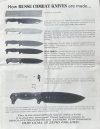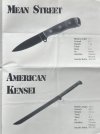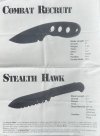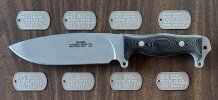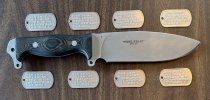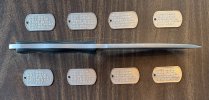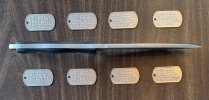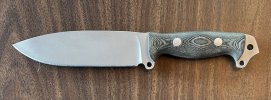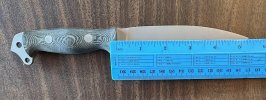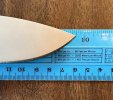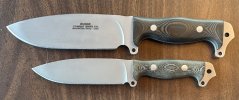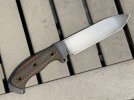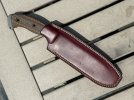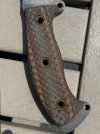Sweet collection! I think the Beating Heart fits nicely into the Survival-Camp-Do all categoriesIt is actually Stonewashed.
Fast becoming my favorite Busse finish.
I have yet to "use" it. Maybe this summer as I do have 2
I still hold to the fact it is a medium War train.
View attachment 2857380
-
The BladeForums.com 2024 Traditional Knife is available! Price is $250 ea (shipped within CONUS).
Order here: https://www.bladeforums.com/help/2024-traditional/
You are using an out of date browser. It may not display this or other websites correctly.
You should upgrade or use an alternative browser.
You should upgrade or use an alternative browser.
Steel Hearts
- Thread starter David Brown
- Start date
Hi, would you say that the Beating Heart is thinner behind the edge than the HR2 & TGULB??
91bravo
Gold Member
- Joined
- Jun 29, 2008
- Messages
- 29,367
I’d love to take one off your hands if you’re ever inclined to get rid of one!It was the original launch in a cupid ganza. I got one not knowing if they would offer any other way. I've since got a few more. Definitely one of my favorite all time models. Would love a HOG edition
- Joined
- Jun 4, 2001
- Messages
- 15,114
but I only have two ???!!!??I’d love to take one off your hands if you’re ever inclined to get rid of one!
and two is one.
Nuker
Gold Member
- Joined
- Jun 22, 2024
- Messages
- 1,115
I‘’ll add a SHSHII
I was told by PO it was Jerry’s first attempt at snakeskin micarta. EDIT: It wasn’t his first attempt, I’ve seen older snakeskin.
0.290” thick INFI
8-3/8” blade (tip to handle)
1-7/8” blade height
13.5” OAL
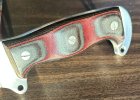






Here’s a great old post on INFI / A2 and other interesting tidbits…
I was told by PO it was Jerry’s first attempt at snakeskin micarta. EDIT: It wasn’t his first attempt, I’ve seen older snakeskin.
0.290” thick INFI
8-3/8” blade (tip to handle)
1-7/8” blade height
13.5” OAL

Here’s a great old post on INFI / A2 and other interesting tidbits…
My understanding is when it comes to INFI vs. A2; the way to look at it is with handle slabs. The transition from A2 to INFI happened before tubes came in the picture. Smooth handle means that there is a higher chance that your SHII is A2, and a possibility of INFI. Partially grooved handles is the opposite. These knives are most likely INFI with a very slim chance of A2, fully grooved handles regardless of slots or not is INFI.
Dimpling is not a good way to tell if it is INFI or not as the dimpling has to do with the HT and not with the type of steel. Only Busse can confirm for sure.
All battle mistresses were INFI regardless of handle types.
All SHSH's with tube fasteners (original) are INFI. This version of SHSH was made sometime around 1999 - 2001.
The lineage of the handle slabs and screws on the SH:
1. Smooth handles, solid pins.
2. Smooth handles, screws.
3. Grooved handles, screws.
4. Grooved handles, tubue fasteners.
5. Swirl-pattern texturing, tubular fasteners (maybe)
Summer/Fall 1999 to Spring/Summer/Fall 2000 brought all these listed changes. It also brought the change from screw type fasteners to tube fasteners. First the Badgers, then a combination of Steel Hearts/Battle Mistress's.
The original Steel Heart is ATS-34. Not all original Steel Hearts were ATS-34 as they were mostly made from A-2. The ATS-34 models are very rare as less than 200 were made.
My understanding was that there are no BBSHSHs in INFI. However, I’ve sent one to Busse recently and was confirmed to be INFI.
The timeline is: SH1, BBSHSH, SHSHII, SHE, FSH. The SHSHII is called a "two" because it was the second version of the straight handle Steel Heart, the BBSHSH being the first, so the SHSH and the SHSHII are the same. There are also two versions of the BBSHSH, one with a "Humpback" blade profile and one with the same blade profile as the SHSHII
Above are my notes from contributions of the older hogs such as Cobalt and Papathud.
Last edited:
Cobalt
Platinum Member
- Joined
- Dec 23, 1998
- Messages
- 17,879
I‘’ll add a SHSHII
I was told by PO it was Jerry’s first attempt at snakeskin micarta.
0.290” thick INFI
8-3/8” blade (tip to handle)
1-7/8” blade height
13.5” OAL
View attachment 2858548






Here’s a great old post on INFI / A2 and other interesting tidbits…
Stunning Steel Heart. Love it
Absolutely love your NMFSH!!
Cobalt
Platinum Member
- Joined
- Dec 23, 1998
- Messages
- 17,879
Here’s a mailer / advertisement from back in the day…
View attachment 2864093
View attachment 2864094View attachment 2864095View attachment 2864096View attachment 2864097View attachment 2864098
Yeah, I think I still have magazines from that time period with ads. I might even have my original tactical knives issue with the A2 steelhead above. Cool memories
Nuker
Gold Member
- Joined
- Jun 22, 2024
- Messages
- 1,115
Brian_T
Gold Member
- Joined
- Oct 7, 1999
- Messages
- 1,766
I see one you’re missing (SH SHII) but that’s an EPIC collection of Steel Hearts.
Nuker
Gold Member
- Joined
- Jun 22, 2024
- Messages
- 1,115
A couple great reference threads:
Interesting old post on Steel Hearts… by Mulder
Mulder
Steel Heart Love!!! Lets see em!!!!!
SH-1 stable growing a bit…
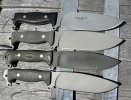
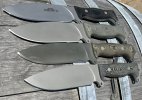
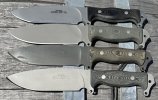
The darker one is a little different. Jerry said it may have been a prototype.
What’s different…
- parkerized after sharpening
- handle slabs
- choil
- plunge line arc, it terminates just at the front of thumb depression
Handle shape / plunge line termination on the parkerized one is kind of similar to the Sweet Heart (bottom)…
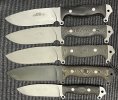
Interesting old post on Steel Hearts… by
Steel Heart Love!!! Lets see em!!!!!
SH-1 stable growing a bit…



The darker one is a little different. Jerry said it may have been a prototype.
What’s different…
- parkerized after sharpening
- handle slabs
- choil
- plunge line arc, it terminates just at the front of thumb depression
Handle shape / plunge line termination on the parkerized one is kind of similar to the Sweet Heart (bottom)…

Nismo17
Gold Member
- Joined
- Aug 30, 2022
- Messages
- 714
Thanks for sharing.I‘’ll add a SHSHII
I was told by PO it was Jerry’s first attempt at snakeskin micarta. EDIT: It wasn’t his first attempt, I’ve seen older snakeskin.
0.290” thick INFI
8-3/8” blade (tip to handle)
1-7/8” blade height
13.5” OAL
View attachment 2858548






Here’s a great old post on INFI / A2 and other interesting tidbits…
This is probably one of the most interesting Busses I’ve seen so in a few years. Great pics
- Joined
- Jun 4, 2001
- Messages
- 15,114
again not meant to be a complete collection of all the hearts out there, just the ones I have.I see one you’re missing (SH SHII) but that’s an EPIC collection of Steel Hearts.
Matteo Escobar
Gold Member
- Joined
- Feb 26, 2002
- Messages
- 4,149
Jaxx
Moderator
- Joined
- Jan 18, 2006
- Messages
- 19,853
BladeForums Benefit Support Auction SHe-v. This variant was donated by Jerry to Spark to help raise money for the continued operation of BladeForums after a major server crash put this site out of operation for what seemed like the longest 8 days in history back in early to mid 2006. Several makers stepped up to help get this site back up and with new equipment by donating knives, but for some reason, this knife didn't get auctioned until November 2009. I won the auction, and it was like stepping back in time. 
Image attribution: Jerry Busse
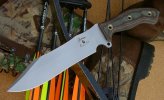
Shown with its Chuddy Bear Leather sheath.
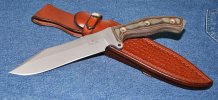
Image attribution: Jerry Busse

Shown with its Chuddy Bear Leather sheath.

Nuker
Gold Member
- Joined
- Jun 22, 2024
- Messages
- 1,115
This Nuclear Heart arrived yesterday & I’m blown away… love it!
Balance point is just behind the talon hole. Burl & giraffe bone. Serrated hollow-ground sharp spine. Only a couple other sightings. It’s from the 2006 Liliputianganzaaaaa (page 2)
Time to give it a little love & wipe down…
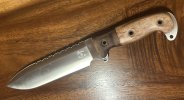
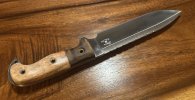

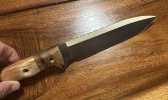
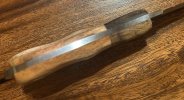
2002 pic/post by Jerry:
Nuclear Heart !!!! (cool pic)
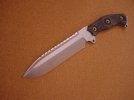
Balance point is just behind the talon hole. Burl & giraffe bone. Serrated hollow-ground sharp spine. Only a couple other sightings. It’s from the 2006 Liliputianganzaaaaa (page 2)
Time to give it a little love & wipe down…





2002 pic/post by Jerry:
Nuclear Heart !!!! (cool pic)

Last edited:
Don't drop it.
Gold Member
- Joined
- Jan 10, 2014
- Messages
- 1,705
Wow! That is amazingThis Nuclear Heart arrived yesterday & I’m blown away… love it!
Balance point is just behind the talon hole. Burl & giraffe bone. Serrated hollow-ground sharp spine. Only a couple other sightings. It’s from the 2006 Liliputianganzaaaaa (page 2)
Time to give it a little love & wipe down…
View attachment 2952305
View attachment 2952307
View attachment 2952309
View attachment 2952310
View attachment 2952311
2002 pic/post by Jerry:
Nuclear Heart !!!! (cool pic)
View attachment 2952315


